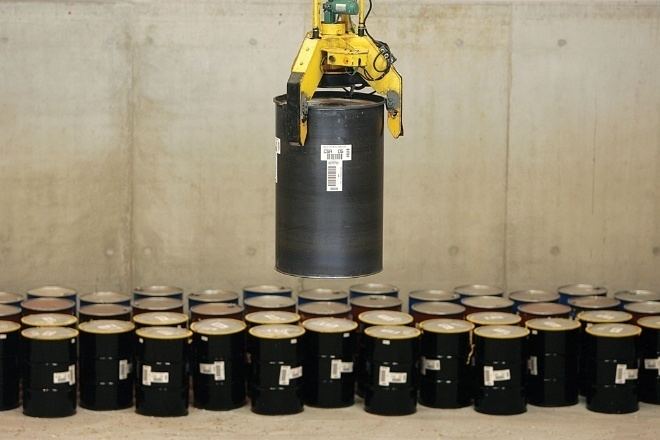 | ||
Uk nuclear decommissioning integrated waste management strategy
Nuclear decommissioning is the process whereby a nuclear facility is dismantled to the point that it no longer requires measures for radiation protection. The presence of radioactive material necessitates processes that are occupationally dangerous, hazardous to the natural environment, expensive, and time-intensive.
Contents
- Uk nuclear decommissioning integrated waste management strategy
- Definition
- Options
- Costs
- Experience
- North America
- Western Europe
- Legal aspects
- Cost
- Decommissioning funds
- International collaboration
- Ships mobile reactors military reactors
- References
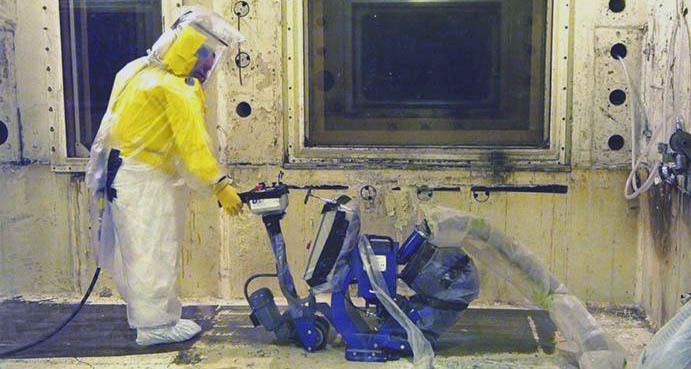
Decommissioning is an administrative and technical process. It includes clean-up of radioactive materials and progressive demolition of the plant. Once a facility is fully decommissioned, no radiologic danger should persist. The costs of decommissioning are spread over the lifetime of a facility and saved in a decommissioning fund. After a facility has been completely decommissioned, it is released from regulatory control and the plant licensee is no longer responsible for its nuclear safety. Decommissioning may proceed all the way to "greenfield" status.
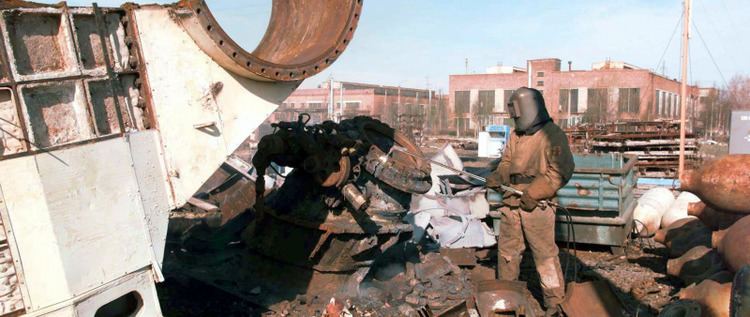
Definition
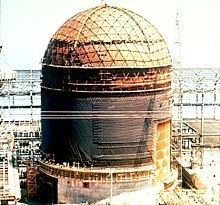
Nuclear decommissioning is the administrative and technical process whereby a nuclear facility such as a nuclear power plants (NPPs), a research reactor, an isotope production plant, a particle accelerator, or uranium mine is dismantled to the point that it no longer requires measures for radiation protection. The progressive demolition of buildings and removal of radioactive material is occupationally dangerous, hazardous to the natural environment, expensive, and time-intensive. Decommissioning may proceed all the way to "greenfield status". Once a facility is decommissioned, no radioactive danger should persist, it can be released from regulatory control and the plant licensee is no longer responsible for its nuclear safety.
Options
The International Atomic Energy Agency has defined three options for decommissioning:
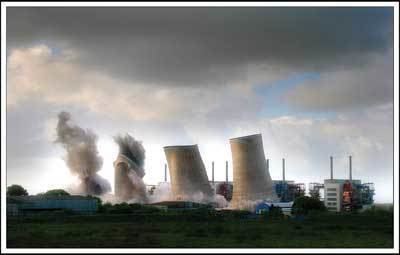
Costs

In the US, the NRC recommends that the costs of decommissioning should be spread over the lifetime of a facility and saved in a decommissioning fund. Repository delay seems to be effective in reducing NPP decommissioning costs.
In 2004, in a meeting in Vienna, the International Atomic Energy Agency, estimated the total cost for the decommissioning of power nuclear reactors in the world at US$ 187 billion; for fuel cycle facilities US$ 71 billion; for all research reactors less than US$ 7 billion; the cost for dismantling all military reactors for the production of weapons-grade plutonium, research fuel facilities, nuclear reprocessing chemical separation facilities, etc. at US$ 640 billion. The total cost to get rid of the obsolescent and polluting nuclear fission industry in the World (from y. 2001 to y. 2050) was estimated around 1 US$ Trillion.
Experience
A wide range of nuclear facilities have been decommissioned so far. The number of decommissioned nuclear reactors out of the List of nuclear reactors is small. To the date of 2016, 150 nuclear reactors were shut-off, in several early and intermediate stages (cold shut-down, defueling, SAFSTOR, internal demolition), but only 17 have been taken to fully "greenfield status". Some of these sites still host spent nuclear fuel in the form of dry casks embedded in concrete filled steel drums.
Several nuclear engineering and building demolition companies specialize in nuclear decommissioning, which has become a profitable business. More recently, construction and demolition companies in the UK have also begun to develop nuclear decommissioning services. Due to the radioactivity in the reactor structure (specially with high neutron-flux), decommissioning takes place in stages. Plans for decommissioning reactors have a time frame of decades. The long time frame makes reliable cost estimates difficult and cost overruns are common even for "quick" projects.
North America
Most nuclear plants currently perating in 2017, in the United States were designed for a life of about 30–40 years and are licensed to operate for 40 years by the US Nuclear Regulatory Commission. The average age of these reactors is 32 years. Many plants are coming to the end of their licensing period and if their licenses are not renewed, they must go through a decontamination and decommissioning process.
Western Europe
A 2013 estimate by the United Kingdom's Nuclear Decommissioning Authority predicted costs of at least £100 billion to decommission the 19 existing United Kingdom nuclear sites.
Legal aspects
The decommission of a nuclear reactor can only take place after the appropriate licence has been granted pursuant to the relevant legislation. As part of the licensing procedure, various documents, reports and expert opinions have to be written and delivered to the competent authority, e.g. safety report, technical documents and an environmental impact study (EIS).
In the European Union these documents are the basis for the environmental impact assessment (EIA) according to Council Directive 85/337/EEC. A precondition for granting such a licence is an opinion by the European Commission according to Article 37 of the Euratom Treaty. Article 37 obliges every Member State of the European Union to communicate certain data relating to the release of radioactive substances to the Commission. This information must reveal whether and if so what radiological impacts decommissioning – planned disposal and accidental release – will have on the environment, i.e. water, soil or airspace, of the EU Member States. On the basis of these general data, the Commission must be in a position to assess the exposure of reference groups of the population in the nearest neighbouring states.
Cost
In USA many utility estimates now average $325 million per reactor all-up (1998 $).
In France, decommissioning of Brennilis Nuclear Power Plant, a fairly small 70 MW power plant, already cost €480 million (20x the estimate costs) and is still pending after 20 years. Despite the huge investments in securing the dismantlement, radioactive elements such as plutonium, caesium-137 and cobalt-60 leaked out into the surrounding lake.
In the UK, decommissioning of the Windscale Advanced gas cooled reactor (WAGR), a 32 MW prototype power plant, cost €117 million.
In Germany, decommissioning of Niederaichbach nuclear power plant, a 100 MW power plant, amounted to more than €143 million.
New methods for decommissioning have been developed in order to minimize the usual high decommissioning costs. One of these methods is in situ decommissioning (ISD), meaning that the reactor is entombed instead of dismantled. This method was implemented at the U.S. Department of Energy Savannah River Site in South Carolina for the closures of the P and R Reactors. With this tactic, the cost of decommissioning both reactors was $73 million. In comparison, the decommissioning of each reactor using traditional methods would have been an estimated $250 million. This results in a 71% decrease in cost by using ISD.
Decommissioning funds
In Europe there is considerable concern over the funds necessary to finance final decommissioning. In many countries either the funds do not appear sufficient to cover decommissioning and in other countries decommissioning funds are used for other activities, putting decommissioning at risk, and distorting competition with parties who do not have such funds available.
In 2016 the European Commission assessed that European Union's nuclear decommissioning liabilities were seriously underfunded by about 118 billion euros, with only 150 billion euros of earmarked assets to cover 268 billion euros of expected decommissioning costs covering both dismantling of nuclear plants and storage of radioactive parts and waste. France had the largest shortfall with only 23 billion euros of earmarked assets to cover 74 billion euros of expected costs.
Similar concerns exist in the United States, where the U.S. Nuclear Regulatory Commission has located apparent decommissioning funding assurance shortfalls and requested 18 power plants to address that issue. The decommissioning cost of Small modular reactors is expected to be twice as much respect to Large Reactors.
International collaboration
Organizations that promote the international sharing of information, knowledge, and experiences related to nuclear decommissioning include the International Atomic Energy Agency, the Organization for Economic Co-operation and Development's Nuclear Energy Agency and the European Atomic Energy Community. In addition, an online system called the Deactivation and Decommissioning Knowledge Management Information Tool was developed under the United States Department of Energy and made available to the international community to support the exchange of ideas and information. The goals of international collaboration in nuclear decommissioning are to reduce decommissioning costs and improve worker safety.
Ships, mobile reactors, military reactors
Many warships and a few civil ships have used nuclear reactors for propulsion. Former Soviet and American warships have been taken out of service and their power plants removed or scuttled. Dismantling of Russian submarines and ships and American submarines and ships is ongoing. Marine power plants are generally smaller than land-based electrical generating stations.
The biggest American military nuclear facility for the production of weapons-grade plutonium was Hanford site (in the State of Washington), now defueled, but in a slow and problematic process of decontamination, decommissioning, and demolition. There is "the canyon" a giant structure for the chemical extraction of plutonium with the PUREX process. There are also many big containers and underground tanks with a solution of water, hydrocarbons and uranium-plutonium-neptunium-cesium-strontium (all highly radioactive). With all reactors now defueled, some were put in SAFSTOR (with their cooling towers demolished). Several reactors have been declared National Historic Landmarks.
